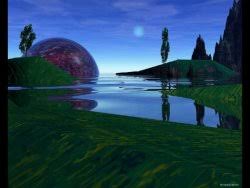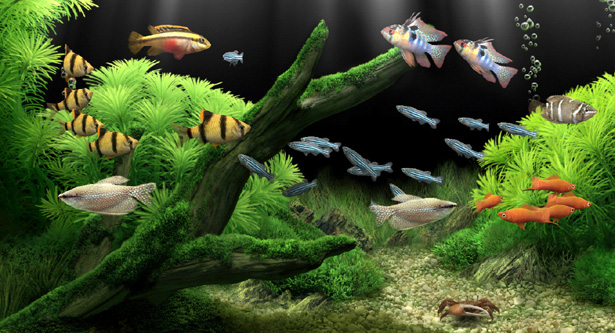Computer Screensavers Biography
After Dark was an early screensaver for the Macintosh platform, and later PC/Windows, which prominently featured whimsical designs such as flying toasters. Perhaps in response to the workplace environment in which they are often viewed, many screensavers continue this legacy of whimsy by populating the idle monitor with animals or fish, games, and visual expressions of mathematics equations (through the use of fractals) as in the Electric Sheep screensaver.
The ability of screensavers to divert and entertain is used for promotion, especially to build buzz for "event-based" products such as feature films.
The screensaver is also an outlet for the work of creative computer programmers. The Unix-based screensaver XScreenSaver collects the display effects of other Unix screensavers, which are termed "display hacks" in the jargon file tradition of US computer science academics. It also collects forms of computer graphics effects called demo effects, originally included in demos created by the demo scene.Screensaver software can also be used as a rudimentary security measure. Many screensavers can be configured to ask users for a password before permitting the user to resume work. However, a user might be able to circumvent the password by restarting the computer if the computer's owner has set their account to automatically log in upon startup.On older versions of Microsoft Windows the native screensaver format had the potential to install a virus when run (as a screen saver was just an ordinary application with a different extension). When any file with the file suffix ".scr" was opened, for example from an e-mail attachment, Windows would execute the .scr (screensaver) file automatically: this had the potential to allow a virus or malware to install itself. Modern versions of Windows can read tags left by applications such as Internet Explorer and verify the publisher of the file, presenting a confirmation to the user.
In addition, on August 5, 2006, the BBC reported that "free screensavers" and "screensavers" respectively were the first and third most likely search terms to return links to malware, the second being Bearshare.[3]






After Dark was an early screensaver for the Macintosh platform, and later PC/Windows, which prominently featured whimsical designs such as flying toasters. Perhaps in response to the workplace environment in which they are often viewed, many screensavers continue this legacy of whimsy by populating the idle monitor with animals or fish, games, and visual expressions of mathematics equations (through the use of fractals) as in the Electric Sheep screensaver.
The ability of screensavers to divert and entertain is used for promotion, especially to build buzz for "event-based" products such as feature films.
The screensaver is also an outlet for the work of creative computer programmers. The Unix-based screensaver XScreenSaver collects the display effects of other Unix screensavers, which are termed "display hacks" in the jargon file tradition of US computer science academics. It also collects forms of computer graphics effects called demo effects, originally included in demos created by the demo scene.Screensaver software can also be used as a rudimentary security measure. Many screensavers can be configured to ask users for a password before permitting the user to resume work. However, a user might be able to circumvent the password by restarting the computer if the computer's owner has set their account to automatically log in upon startup.On older versions of Microsoft Windows the native screensaver format had the potential to install a virus when run (as a screen saver was just an ordinary application with a different extension). When any file with the file suffix ".scr" was opened, for example from an e-mail attachment, Windows would execute the .scr (screensaver) file automatically: this had the potential to allow a virus or malware to install itself. Modern versions of Windows can read tags left by applications such as Internet Explorer and verify the publisher of the file, presenting a confirmation to the user.
In addition, on August 5, 2006, the BBC reported that "free screensavers" and "screensavers" respectively were the first and third most likely search terms to return links to malware, the second being Bearshare.[3]
Computer Screensavers

Computer Screensavers

Computer Screensavers


Computer Screensavers
Computer Screensavers
Computer Screensavers

Computer Screensavers

Computer Screensavers

Computer Screensavers
Free Animated Computer Screensavers
Computer Screensavers
Fun Sunset All In One Art Computer Screensavers Video

No comments:
Post a Comment